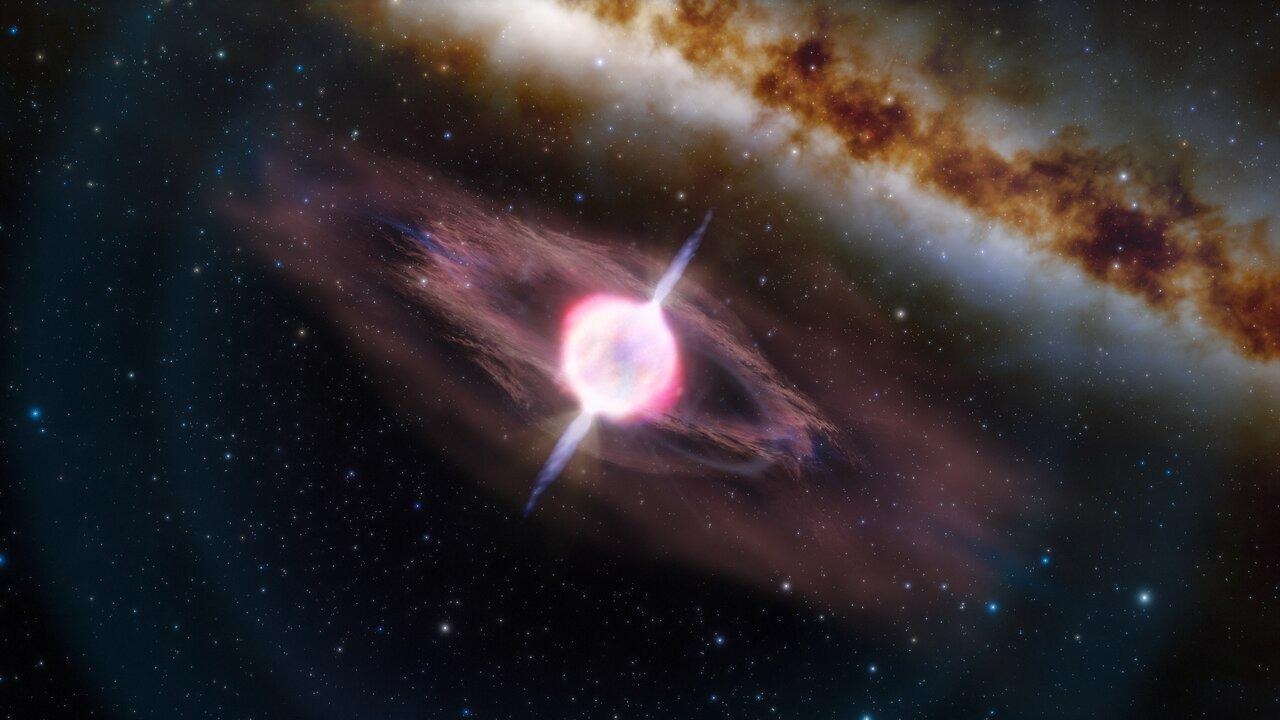The shortest-ever gamma-ray burst (GRB) caused due to the collapse of a massive star has been discovered by astronomers.
 Illustration of a Short Gamma-Ray Burst Caused by a Collapsing Star. Image Credit: NOIRLab.
Illustration of a Short Gamma-Ray Burst Caused by a Collapsing Star. Image Credit: NOIRLab.
The astronomers employed the International Gemini Observatory, a Program of NSF’s NOIRLab, have found out the reason behind this 0.6-second flurry of gamma rays as a supernova explosion in a faraway galaxy.
Generally, GRBs resulting from supernovae measure twice as long, which indicates that few short GRBs might be imposters — supernova-produced GRBs undercover.
GRBs are some of the most energetic and brightest events in the universe. However, researchers are still trying to identify the exact reason for these fleeting events. GRBs have been split into two broad groups by the astronomers based on their time. Short GRBs blaze into life within 2 seconds and are believed to be caused by the fusing of binary neutron stars.
Long GRBs are the ones that last longer and have been accompanied by supernova explosions resulting from the implosions of massive stars. Yet, the recent breakthrough of the shortest-ever GRB generated during a supernova indicates that GRBs do not match exactly into the boxes that have been created for them by the astronomers.
This discovery represents the shortest gamma-ray emission caused by a supernova during the collapse of a massive star. It lasted for only 0.6 second, and it sits on the brink between a successful and a failed gamma-ray burst.
Tomás Ahumada, PhD Candidate and Study Lead Researcher, University of Maryland
Ahumada is also an astronomer at NASA’s Goddard Space Flight Center.
The researchers think that GRB and a few other supernova-related GRBs seem to be short due to the jets of gamma rays that arise from the poles of the collapsing star. It denotes that they are not so powerful to escape the star completely, almost failing to produce a GRB and that other collapsing stars exhibit such weak jets that entirely lack the potential to produce CRBs.
Furthermore, this breakthrough could help unravel an astronomical mystery. Long GRBs are connected with a particular type of supernova (known as Type Ic-BL). Yet, astronomers note many more of these supernovae compared to the long GRBs.
The discovery of the shortest GRB linked to a supernova indicates that a few of these supernova-caused GRBs are masquerading as short GRBs and are believed to be made by neutron-star mergers, and are, therefore, not taken into account as the supernova kind.
Our discovery suggests that, since we observe many more of these supernovae than long gamma-ray bursts, most collapsing stars fail to produce a GRB jet that breaks through the outer envelope of the collapsing star. We think this event was effectively a fizzle, one that was close to not happening at all.
Tomás Ahumada, PhD Candidate and Study Lead Researcher, University of Maryland
The researchers could identify that this GRB, known as GRB 200826A, was formed from a supernova explosion as a result of the imaging abilities of the Gemini Multi-Object Spectrograph on Gemini North in Hawai‘i.
The scientists made use of Gemini North to achieve images of the GRB’s host galaxy 28, 45 and 80 days following the initial detection of GRB on 26th August 2020, by a network of observatories that also involved NASA’s Fermi Gamma-ray Space Telescope.
The observations of Gemini enabled the researchers to detect the tell-tale increase in energy that denotes a supernova, despite the location of the blast in a galaxy that is almost 6.6 billion light-years away.
This was a complicated endeavor as we needed to separate the light of an already faint galaxy from the light of a supernova. Gemini is the only ground-based telescope that can do follow-up observations like this with a flexible-enough schedule to let us squeeze in our observations.
Tomás Ahumada, PhD Candidate and Study Lead Researcher, University of Maryland
This outcome of the study shows that classifying GRBs based only on their duration might not be the best method and, therefore, further observations are required to find the cause for a GRB.
Ahumada added, “We were originally hunting for merging neutron stars, which are thought to produce short gamma-ray bursts. Once we discovered GRB 200826A, however, we realized that this burst was more likely to be caused by a collapsing star’s supernova, which was a surprise!”
“The Gemini observatories continue to shed new light on the nature of these incredible explosions occurring across the distant Universe. Dedicated instrumentation arriving for use over the next decade will maintain Gemini’s leadership in the follow-up of these awe-inspiring cosmic events,” stated Martin Still, Gemini Program Officer at NSF.
Journal Reference:
Ahumada, T., et al. (2021) Discovery and confirmation of the shortest gamma-ray burst from a collapsar. Nature Astronomy. doi.org/10.1038/s41550-021-01428-7.